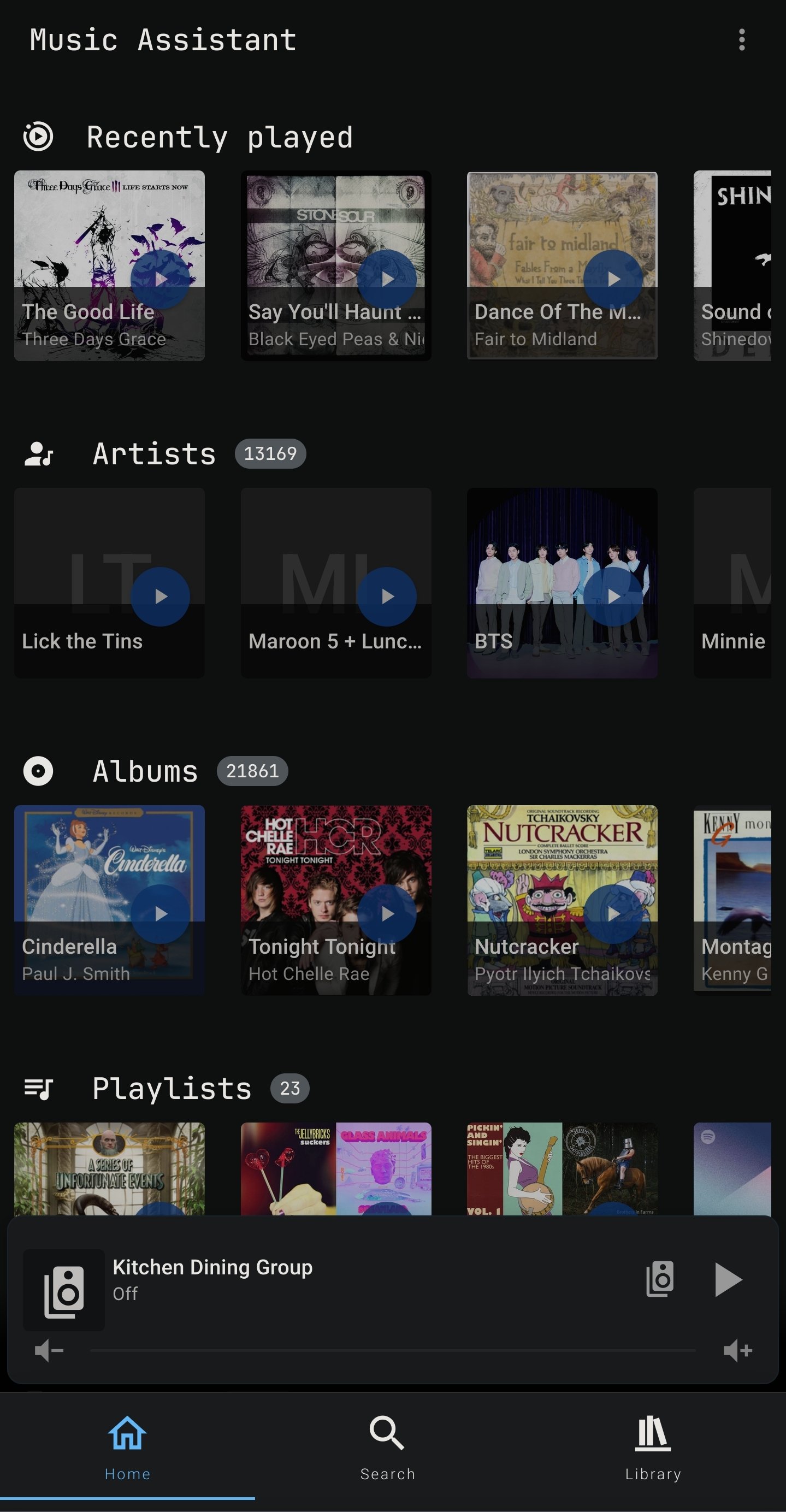hello,
im really tired of google music and spotify, and want to self host my downloaded music and create my library.
however, i know nothing about self hosting. My knowledge is absolutely zero. And Im completely lost about how to self host my own music. Dont find any good tutorial for dummies and i have a lot of question. I dont understand nothing. I see the tutorials of Navidrome and Ampache and still understand nothing. All of that looks extremely complicated to me.
How can i self host my music? I need to pay something? A very old and slow pc is enough?
Im completely lost. If someone can suggest something - like a tutorial , dunno - to build/self host my own music I appreciate a lot.
ty
I use Jellyfin. You can find a very easy to deploy docker container by linuxserver.io team. Jellyfin has dedicated music only apps as well, for phones as desktops.
Maybe this is a stupid question, but what do you achieve with self-hosting music? What do you do with it? If it’s only on localhost then I could just play the music locally? what is it for? :)
I forward it to my domain, so that I can listen to music in my office or anywhere else.
I have a VPS on hetzner, and I forward all my local traffic through that VPS via TLS-passthrough, not TLS termination using WireGuard amd HAProxy.
To know more about my setup, you can this this. https://blog.aiquiral.me/bypass-cgnat
Depends what you want to play it on. In my house we have:
3 laptops 2 tablets 2 mobile phones (1 android, 1 iPhone) TV
Not all these devices support local storage for music and it’s a pain to sync files between them. With Jellyfin the complete library is in one location with a consistent interface. It can also be made available remotely if I choose.
That actually makes a lot of sense, thanks!
Welcome
jellyfin is a streaming server. get yourself a domain name and you can connect your apps to it from anywhere.
You can stream it wherever you are in the world without having to keep it on your phone
I’ve always wondered that. Why use linux server’s images over official ones? Are they somehow better?
When I first used Jellyfin, the official Docker image didn’t have AMD video acceleration working out of the box and the LinuxServer one did.
LinuxServer images often solve problems and work out of the box better than the official option.
I think I’m right in saying they have a standardised and reliable option for running as a none-root user too.
For normal docker self hosters the biggest is similar structures across their images.
It config is always /config
Also they run the same user so it helps with file permission issues
Hmm, never looked at it this way. I might start using their images too.
Questions about the user:
1- Their docs says it may be risky to run the app as root. Is the root in the docker container same as root of the host? I thought it was root but only in the container, separate from the host root’s namespace.
2- And in terms of volume ownership: if I’m using Docker volumes instead of bind mounts, do I care about that? I haven’t had an issue so far.
They’re relatively easy to deploy.
Or just run Jellyfin on your desktop and sync the phone app from time to time. Finamp even allows downloads, so no connection to the server needed at all times.
That is a different usecase though. That is simply syncing local musical with a server.
I do that too because i have an SD card. Just use Syncthing for that. Much faster and less hassle. You can use any music player on your phone that you want, not just one that works with jellyfin.
If you aren’t streaming music in real time for the majority of time, then do a phone sync, not a streaming server.
I got jellyfin ln my synology nas. Been working fine for a year or two now. Finamp is the dedicated audio app for that.
What I’ve been doing:
Easy option: because I only have around 40gb of music, I sync it between my PC and my phone using syncthing since 128gb is the minimum nowadays
Hard option: streaming is cooler so I installed nextcloud with an optional plugin called “music” which allows to connect an app called “ultramusic” and it becomes “self hosted Spotify” with android auto support and all the bells and whistles. Disadvantage: Nextcloud is a moving target. For some reason they have to release new incompatible versions every two or three months. So for plugin developers this is a very annoying upgrade threadmill that eventually leads to burnout and that plugin dies. Even officially supported plugins sometimes don’t support the latest version when they launch it. If you choose to use nextcloud with docker, make sure to stay behind 1-2 versions (tag nextcloud:28 when nextcloud:30 is released) or your plugins might suddenly break without any warning. According to fanboys this is the industry standard nowadays and it’s up to the user to manually check the GitHub issues of each of the 30 plugins if it’s compatible before updating. Even if it’s official plugin. They call it “stable” but they mean “beta testing for the paid enterprise version”.
however, i know nothing about self hosting. My knowledge is absolutely zero […] I dont understand nothing
This is going to be a problem, unfortunately. You’ll need to define your use case first:
- How much music do you want to have access to? Hundreds, thousands, millions of files? How large is your collection?
- Do you have downloaded copies of all the music you want to listen to? Are they all in one place, well organized and tagged? If you just have downloads in the Spotify app, you won’t be able to use those files, you don’t actually own that music. You’ll need DRM-free audio files.
- Where and how do you want to be able to access them? Just from one device like your phone? Many devices? Is having access at home good enough, or do you want to be able to access your collection while you’re away from home?
- Will you be the only user?
- What kind of budget do you have to work with?
An old PC might be enough to act as a server, but there’s more involved and the answer to what you need depends on what exactly you want to do. You will not be able to build a personal version of Spotify with just an old PC, for instance.
Skimmed comments, but if you download and manage your music on your own on a machine you can have a super simple setup like I do. All music is synced using Syncthing to my phone. So my phone gets local storage, and then I use Poweramp (android) to play it.
I pretty much have a folder for all the music though. But I assume you can sort music into folders to have them as playlists. But perhaps not as practical as desired.
Isn’t Syncthing for Android getting sundowned?
Use syncthing-fork from fdroid.
The fork isn’t
Wha?! I didn’t know this was happening… Damn, that was my solution to multiple applications
So, self hosting is complicated. Everyone in this comment section has had tons of experience with it. I tried Plex, failed. Jellyfin, didn’t connect. Entire OSes on a raspberry pi, didn’t work.
I don’t know your situation but for me giving up and just keeping it stored on my phone and manually updating is good enough.
Navidrome server. Use podman. Buy a Fully qualified Internet address first, then go to cloudflare and proxy your IP to the new. Address. Finally in android install Ultrasonic or Subsonic and go to your server.
You don’t need to have a Fully qualified Internet address. But I like it better than having to remember 55.655.67.533. but the IP address still works fine. The thing about the cloudflare proxy is that it never reveals your IP. So in case someone might be snooping around, they gotta get past cloudflare first.
Is there a way to do this if you don’t have a static IP and don’t want to use cloudflare?
I don’t have any links to hand, but look into Dynamic DNS. It’s basically a way for your device / router to talk to your domain registrar, and update their DNS records whenever your IP address changes.
Have a look at DuckDNS as a starting point.
Yeah the way I have mine now, it’s through dynamic dns
Even without all this DNS thing, you can always reach your own IP from outside. The issue becomes a security issue. You will need to route your PC’s specific Navidrome port. You can use any port you like, but you’ll need it exposed thru. So that opens your system up for attacks from outside. With the cloudflare thing you can safely access your computer from outside without opening ports.
However you can sort of do this too by adding a couple more pod apps and using a dynamic DNS service. Portainer or cockpit, Pihole, and Ngnix Proxy Manager.
With portainer or cockpit you can organize the pods so they start-up automatically for example. Using your router, split your network into two separate ones … One for yourself and another for your exposed stuff. Then use the pihole to protect them. Next set-up Ngnix proxy to route to different ports. If you get to my music.com, then it will route the name to a port. Without DNS you can also just route from your outside IP to a local host name. For example 56.45.35.76:657/music could route to NABODROME the local host name or simply to 192.168.7.12. there’s a ton of tutorials on how to set these up on YouTube so go have fun. You might choose not to get into all this because it’s a little complex. But you could, like many of us, really like it, and then you enjoy a little freedom.
Back in the day I used to use dynamic DNS.
I use a Plex server and the PlexAmp app wherever I want to listen. There are probably better options, but it’s something I set up years ago which was dead simple and requires almost no maintenance.
PlexAmp is an amazing bit of software for a phone. It doesn’t translate well to the desktop, but it’s still pretty good.
Your flacs will play lossless on wifi, and transcode to 128kbps opus on mobile. You can tweak those settings too.
Most smart TVs have a native plex app available too.
Yup, that’s what we do as well. 30tb of music, TV, and movies. All available to me and my friends wherever we are.
Plexamp is the best music service I’ve ever used and it’s a great way to get into self hosting. Once it’s set up why not add some tv and movies?
Agh Plex always rubs me the wrong way… It acts like closed source software as much as is possible. Went with Jellyfin and it’s been great. But haven’t tried music.
I use Jellyfin for all my video but I use Plex for my audio. Plex app is just so much better than finamp.
I actually plan on switching to Jellyfin soon but I think I’ll keep Plex running just for Plexamp
I run both for a similar reason. It’s the same library, point both services at it and you have more choice of apps. Yet another benefit to self hosting.
Take a look at the Finamp desktop client. It comes very close to the Plexamp client from back when I was using Plex.
I have heard symphonium is very good if they are looking at closed source Plex anyway. It works with jellyfin and navidrome.
I just use syncthing to sync all of my music to my phone’s SD card. Then PowerAmp since there aren’t many fully featured foss music players. I am keeping my eye on Auxio though, keeping it installed and updated.
I started with TV and movies and thought why not add some music!
Symphonium is a great Android music player which connects to a Subsonic or Jellyfin server (or any other protocol like SMB).
Navidrome is a music server which implements the Subsonic protocol. This means apps like Symphonium can connect to it.
Any old PC is enough, even a Raspberry Pi is fast enough for a music server.
- Install Navidrome on the server/pc
- Configure Navidrome (open ports, add your music library/folder)
- Connect a subsonic-compatible music app to to the server (I.e. type in IP or domain as well as the port).
Anything more like SSL (https) and a domain is optional for getting it working, and only a benefit if used outside of your home network. Using Tailscale makes a domain/SSL unnecessary and also no longer needs messing around with networking (e.g. no opening ports on the router).
On the topic of SMB. If OP is mostly interested in accessing the music from their phone, a symfonium + SMB server setup may be even easier than setting up navidrome
Can confirm. I have an arm board from 2010 with 256MB of RAM. it hosts music fine through minidlna and still has memory and cpu free
I use synphonium with my jellying server, works just fine.
I checked out Tailscale, and my 👀 popped when I realized what it does! 😄
I proceeded to install it on my phone, only to realize a moment later that my connection was down. I headed over to my Rethink DNS firewall and saw that Tailscale had taken over my VPN connection, causing Rethink to shut everything down (as it’s supposed to).
Now, unfortunately, I’m probably gonna find out that Tailscale needs highly sought out for VPN slot on Android, and that I can’t use it because I’d have to drop my firewall? 🙈
Yes, the restriction to a single VPN client is annoying.
Blocking ad/telemetry domains can be done by adding Adguards DNS servers in the OS settings. Sadly blocking apps Internet permissions completely is not possible (except on OS like LineageOS, CalyxOS or GrapheneOS).
Yep, was afraid of that. Sadly, not a solution for me then.
Thanks nevertheless! 🍻
I’m going to go another route here: do you need streaming?
Like, I’ve simply gone with a giant pile of FLACs that I put on a SD card for my phone, and use over the NAS for when I’m at home and don’t currently use any fancy-pants streaming stuff.
So like, depending on how you’re using your music library, you might not even need to drop deep into the giant self-hosting rabbithole for this.
I mean, most high-end phones today doesn’t support SD cards so this can be a reason why to selfhost.
Based on OPs experience this is the best solution.
If they want to learn, I found plex + plexamp was pretty easy to get going.
FLACs
on a phone
in SD card
¿??? it’s not like you’re going to be able to autism at a -0.0002dB disparity on the trumpets channel with those audio chips, why not just store the files there as opus or MP3 for ~6x more capacity? (not to mention faster overall reads)
Because I stuck a 1TB sd card in my phone and don’t have to deal with transcoding or dealing with, well, anything, but copying new files over and listening to things.
I’ve developed quite the liking for stupidly simple solutions, and ‘copy the files to a sd card’ is about as simple as it gets.
OPUS is such a delightful format I transcoded my FLACs just for fun.
OPUS is such a delightful format
Agreed. My audiobook library was transcoded from various formats to 32kbit OPUS and they still sound about the same.
Shocking how decent it is with spoken voice and stupid low bitrates.
I’ve been using ogg vorbis for music since about the mid 2000s. In the begining I was ripping them from my CD collection using grip on mandrake Linux (anyone remember?)
Nowadays I download vorbis direct from bandcamp.
Recently I compared 192 kbps vorbis files to FLACs and couldn’t discern the difference, which I’m happy about since my 15000 file collection can fit on a very cheap 128GB SD card in my phone.
I use syncthing to sync music to my phone automatically.
Really happy with the setup.
Are you retarded or deaf?
that I put on a SD card for my phone
Pretty soon you won’t be able to buy a phone without expandable storage. On the plus side, internal storage is going up, but it’s still not big enough to hold a complete FLAC collection if it’s a reasonably large library. You can re-encode your library just for phone usage, but that’s a bit annoying to maintain.
Also, I’ve found all of the offline music players on Android kind of suck, and don’t support the workflow I like or have bugs.
There are lots of solutions, but as others have noted, Plex with Plexamp is great.
I’d recommend getting a NAS for storage and running mirrored disks. This way you’ve got some redundancy in the event of a disk failure.
There are many different ways, but personally (and hopefully I don’t get crucified for saying this) I use Plex and Plexamp. Plexamp has got to be the best music app I’ve ever used. I even tied it into Last.fm to get recommendations for new music based on my listening.
You’d need to set up Plex media server to go this route: https://support.plex.tv/articles/200264746-quick-start-step-by-step-guides/
Personally I host via Docker.
It might be a little overkill if you don’t have other media, though, and it’s not fully open source.
I use Plex and jellyfin, honestly, plex only stays around because of plexamp. It’s just too good. I don’t like using streaming apps like Spotify or whatever because they’re not as good
@greedytacothief @AmbiguousProps How does Finamp compare?
Not necessarily overkill, you can run Plex on almost anything. I used to run it on an old NUC6 I had laying around, then upgraded to a NUC8, and more recently I setup it up as a VM on Proxmox on a Ryzen 5700u mini-PC and just reimported the DB.
Virtualizing it has been good for my purposes since now it’s running alongside AssetUPnP, AudioBookshelf, and a dockerized squeezelite setup, and I’ve another VM on the host running Home Assistant with still plenty of resources to spare. Crazy we can do that now with a “server” that literally fits in my palm.
But virtualizing it makes hardware acceleration for video transcode be I more complicated, just a heads up. I play everything native so don’t use it, but YMMV.
———
Edit - Plexamp is an awesome radio/DJ player, though I generally send to a Wiim Mini, as AirPlay quality with Plexamp can be kind of ass compared to direct DLNA.
Plex is good and the Plexamp app for music is excellent.
Jellyfin + Finamp has been pretty good for me.
Any chance Jellyfin and Finamp have a music playlist and mix building feature?
Plex has this with Plexamp but I have not had a chance to look into jellyfin to see if a plugin offers something similar.
I hate building playlists, Plex offers a few different options like sonic sage, sonic adventure, artist mix builder, and automatic mixes based on past listening history.
deleted by creator
deleted by creator
was mentioned in the post
That’s what I get for skimming.
lol it happens
Scamming is bad, think of the victims.
Music assistant on home assistant or without HA will let you host your own music but also allow for the addition of streaming providers. It lets you cast your collection to pretty much any speakers. You can even build your own cast receivers with any android device and squeeze cast.



















